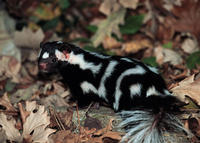EASTERN SPOTTED SKUNK

This small (16-23 inches) skunk is more weasel-like in body shape than the more familiar striped skunk. The Spotted Skunk's stripes are broken in pattern, giving it a "spotted" appearance.
Spotted Skunks seem to prefer forest edges and upland prairie grasslands, especially where rock outcrops and shrub clumps are present. In western counties, it relies heavily on riparian corridors where woody shrubs and woodland edges are present. Woody fencerows, odd areas, and abandoned farm buildings are also important habitat for Spotted Skunks.
Spotted Skunks may occur in suitable habitat anywhere in the state. The marked counties are those for which occurrence has been documented or within which critical habitat has been designated.

Eastern Spotted Skunks are protected by the Kansas Nongame and Endangered Species Conservation Act and administrative regulations applicable thereto. Any time an eligible project is proposed that will impact the species' preferred habitats within its probable range, the project sponsor must contact the Ecological Services Section, Kansas Department of Wildlife, Parks and Tourism, 512 SE 25th Ave., Pratt, Kansas 67124-8174. Department personnel can then advise the project sponsor on permit requirements.
DESIGNATED CRITICAL HABITATSAs defined by Kansas Administrative Regulations, critical habitats include those areas documented as currently supporting self-sustaining population(s) of any threatened or endangered species of wildlife as well as those areas determined by the Kansas Department of Wildlife, Parks and Tourism to be essential for the conservation of any threatened or endangered species of wildlife.
Currently, the following areas are designated critical for Eastern Spotted Skunks:
(1) All suitable habitat within Barton, Anderson, Woodson, Wilson, Chautauqua, Montgomery, and Labette counties.
(2) All suitable habitats within the Cowskin Creek and Big Slough drainage basins located in Sedgwick and Sumner counties.
(3) All suitable habitat within a riparian corridor along the main stem Arkansas River in Finney, Ford, and Gray counties. The corridor's outermost boundary is along a line 0.5 mile landward from the named stream's ordinary high water mark on each bank.
(4) All suitable habitats within the Big Creek drainage basin located in Ellis and Trego counties.







